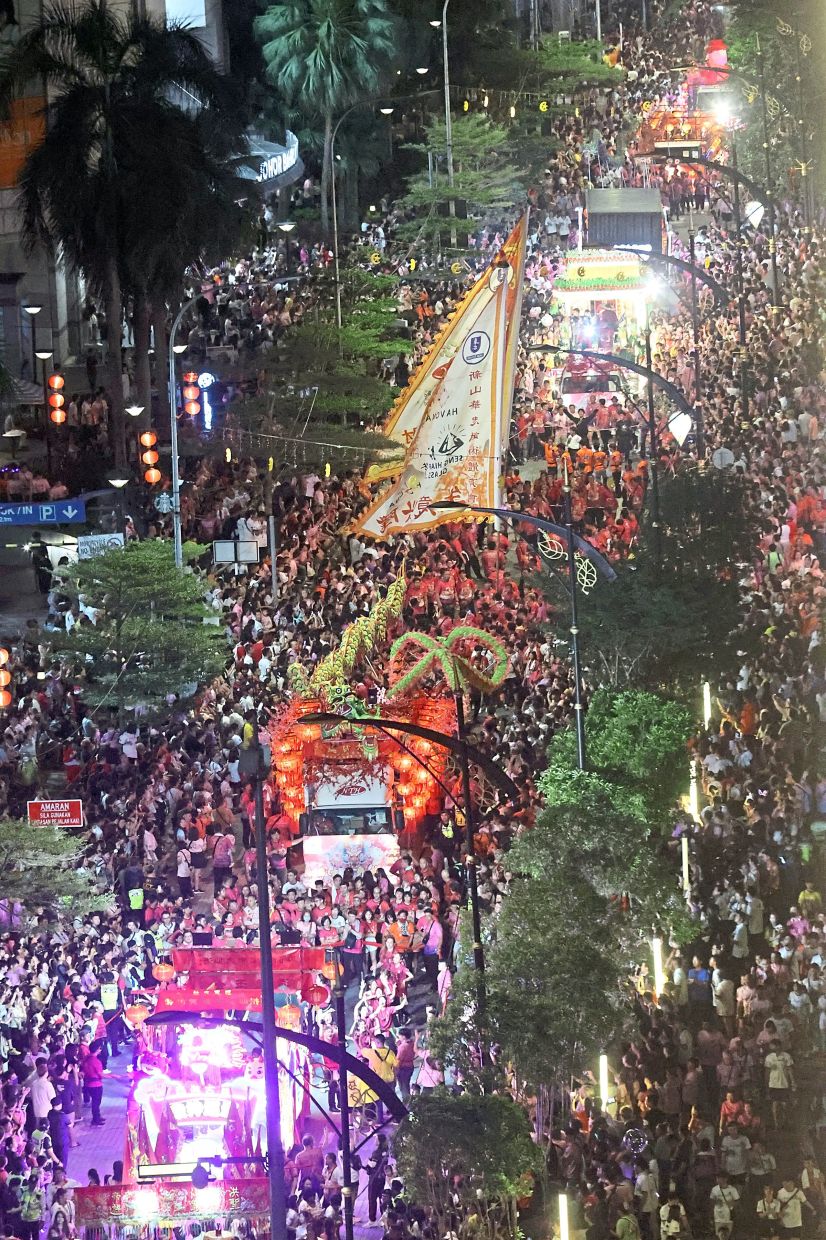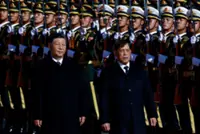Lively atmosphere: Dragon and lion dance performances and colourful floats accompany devotees carrying clan deities from Johor Ancient Temple to Xing Gong temple on day three of Chingay Festival in Johor Baru. — THOMAS YONG/The Star
Over 300,000 people gather to witness colourful procession of five clan deities as Chingay winds through Johor Baru
THE Chingay Festival in Johor Baru, which has a rich history spanning more than a century, is finding new fans among the younger generation who are embracing its colour and pageantry.
More young folks are taking part in the festival organised by Johor Ancient Temple, which attracts thousands of people every year and is an important part of the Chinese community here.
This year’s Chingay festival was held from Feb 27 until March 2, with festivities culminating in a procession carrying the five clan deities and snaking its way through 8km of main roads in the city centre, which were closed off in sections.
ALSO READ: Foreign visitors awed by festival
There were also lion and dragon dance troupes, drum performances, flag acrobatics and floats to mark the occasion.
For 18-year-old ballet dancer Elena Koh, Chingay holds many fond memories. She has been going to the annual festival with her family since she was four.
“My favourite part about the five-day event has always been the dragon and lion dances because of their colourful features and lively movements.
“When I was younger, I always thought the performers looked cool while doing their routine.
“I was inspired to take up dragon dancing by joining the Johor Ancient Temple dragon dance troupe about five years ago.
“Since then, I have been participating in Chingay as a performer rather than just walking with the procession along the route.
“This has established an even deeper connection in the festival for me,” she said in an interview with StarMetro.
Koh said she had to learn various parts of dragon dance, including playing the musical instruments and holding the “pearl” which was attached to a long pole.
“I found this quite challenging as the pearl leads the dragon during a performance, so I need to be flexible and quick on my feet.
“Thankfully, my ballet training gives me some advantage as I understand the movements well, although they are in completely different disciplines,” said the youth who also works as an assistant ballet teacher.
“I also want to show people that Chingay is not just participated by older people. Many people my age are passionate about joining the yearly event, both as a performer and spectator and I believe this is the key in keeping the tradition alive for years to come,” she added.
Another frequent Chingay participant, Stuart Tan, 27, said he had been taking part in the festival since he was in secondary school more than 10 years ago.
“It is a significant event for Johoreans, especially the Chinese community, and I used to attend with my classmates as a way of concluding our Chinese New Year celebrations.
“Now that we are all working and leading our own lives, we use the event as an opportunity to gather and have an informal reunion,” said the ehailing driver, who described the festival atmosphere as carnival-like.
Although following an 8km route might sound daunting to some, it was fun when undertaken with friends, said Tan.
“Of course, the main objective of the procession is to accompany the five deities on a tour of the city centre but it is also a chance for participants to get to know Johor Baru better,” he said.
This year’s Chingay was a particularly memorable one for Wong Kim Ching as she and her friends became the centre of attention when they arrived at Xing Gong Temple in Jalan Ulu Ayer Molek – the starting point of the city-centre procession – in matching red outfits, with a few of them wearing heels as high as 15cm.
“I have been attending Chingay for many years but it is a first for my four friends, so we decided to try something new by dressing up in cheongsam and suits made from the trendy and striking Dongbei flower print.
“When we arrived, many people including police officers asked to take photos with us and we felt like minor celebrities.
“It was an unforgettable experience,” said the 41-year-old weight management coach, adding that their outfits cost about RM2,000 each.
Wong said one of her friends, Liu Jing, a Chinese national who has been living in Johor Baru for about a decade, was impressed by the elaborate celebrations and festivities as Chingay was not observed in her country.
She said they looked forward to participating in next year’s festival and had already started planning their outfits.
Rituals and festivities
The Chingay festival is celebrated by the Chinese community in Johor Baru from the 19th to 22nd day of Chinese New Year.
Roads such as Jalan Trus, Jalan Wong Ah Fook, Jalan Ngee Heng, Jalan Ulu Ayer Molek, Jalan Yahya Awal and Jalan Dato’ Onn were closed off in sections over the five days for the festivities.
The event kicked off with a lighting ceremony on Feb 27 to signify the start of the festival.
The next day, the “street cleansing” ceremony was held where devotees symbolically sprinkled holy water along the procession route to ward off evil spirits and make way for the deities.
On the third day, each of the deities representing the five main dialect clans – Hokkien, Cantonese, Hainan, Hakka and Teochew – were brought out by devotees on palanquins from Johor Ancient Temple to Xing Gong temple, located 3km away.
Johor Baru Tiong-Hua Association president Ho Sow Tong said Xing Gong temple was like a “hotel” where the deities were temporarily placed overnight before the procession day.
“On the fourth day, also known as the highlight of the festival, tens of thousands of devotees and performers on foot as well as floats move along the route to accompany the deities as they bless the city and its people for the year.
“The procession starts at Xing Gong temple beginning at 7pm and ends well past midnight back at the same place.
“On the final day, the deities are brought on foot back to Johor Ancient Temple where they stay for the rest of the year,” he explained.
Ho said the tradition had been ongoing for more than 150 years and he was glad to see even more youths participating in the event this year.
“Back in the day, it was a challenge to look for young people who were willing to carry the heavy palanquins.
“Those in the temple committees were older men and they had to hire labourers to carry the palanquins.
“This changed in the past few decades where more and more younger devotees volunteered to carry them even though it is hard work and intense to do so along the long route,” he said, adding that groups of devotees would usually rotate along the way to share the burden.
Ho estimated that more than 300,000 devotees and spectators showed up to watch the procession this year, with the usual joyful shouts of “heng, ong, huat” (good luck, fortune and prosperity).
It was also the first time that His Royal Highness Tunku Ismail, The Regent of Johor, officiated the festival.
“We were pleasantly surprised when he brought along his young son and daughter.
“The Royals stayed for more than an hour enjoying the cultural performances from the main stage set up at Jalan Wong Ah Fook,” Ho said, adding that they also smiled and waved at the passing procession.
Johor Mentri Besar Datuk Onn Hafiz Ghazi, state health and environment committee chairman Ling Tian Soon and China ambassador to Malaysia Ouyang Yujing were among dignitaries sharing the stage with the royals.
The name Chingay comes from the Hokkien dialect which means the art of costume or masquerade.
There is a local saying that Chingay marks the end of Chinese New Year celebrations for Johoreans.
“The festival used to be a religious practice but over the years, it has become a celebration of culture and unity.
“Seeing the involvement of youths gives us hope that this ancient tradition will not be lost,” said Ho.










